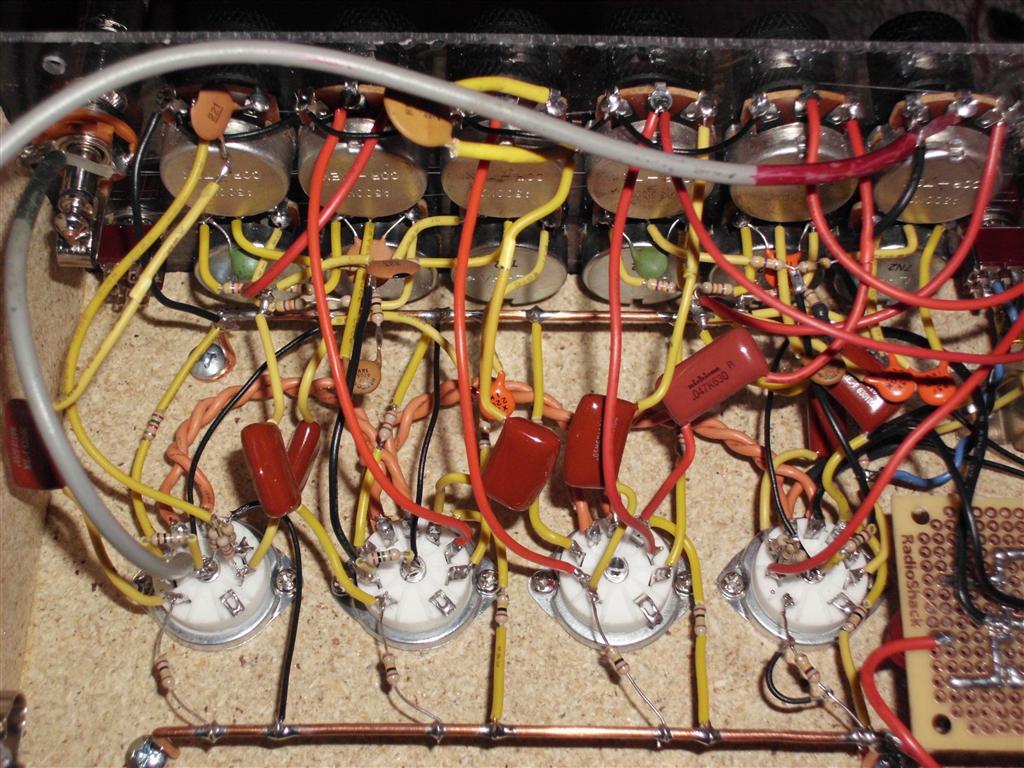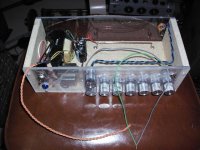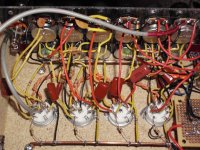Hi. Can someone explain the fundamentals of tube distortion (for guitar)?
I have a pretty good understanding of tube amplifiers and I know how to clip a signal but I need more info on how each stage of distortion is driven. What makes the magic? What makes guitar distortion sound compressed and layered?
What I'm building uses a cathode follower (1/2 12ax7/12au7) on the front end to drive a 3-band tone stack then 4 distortion stages (2x 12ax7) then another cathode follower (1/2 12ax7/12au7) into another 3-band tone stack. This allows me to shape the signal from the pickup then shape the output.
So, I have 4 triodes to clip. I plan on putting a pot between each stage because I believe each has to be adjusted precisely so they all begin to clip at roughly the same time with #4 clipping first, then 3, 2 and finally 1. I think this is how the distortion layers up harmonics as the input gain it increased. This would also explain the compression effect where the sound seems to be mashed together. The 4th stage, being clipped first, can't get any louder and each prior stage adds more and more harmonics, as they come into clipping, but don't actually add to the output level.
Sound somewhat correct?
I have a pretty good understanding of tube amplifiers and I know how to clip a signal but I need more info on how each stage of distortion is driven. What makes the magic? What makes guitar distortion sound compressed and layered?
What I'm building uses a cathode follower (1/2 12ax7/12au7) on the front end to drive a 3-band tone stack then 4 distortion stages (2x 12ax7) then another cathode follower (1/2 12ax7/12au7) into another 3-band tone stack. This allows me to shape the signal from the pickup then shape the output.
So, I have 4 triodes to clip. I plan on putting a pot between each stage because I believe each has to be adjusted precisely so they all begin to clip at roughly the same time with #4 clipping first, then 3, 2 and finally 1. I think this is how the distortion layers up harmonics as the input gain it increased. This would also explain the compression effect where the sound seems to be mashed together. The 4th stage, being clipped first, can't get any louder and each prior stage adds more and more harmonics, as they come into clipping, but don't actually add to the output level.
Sound somewhat correct?
It's a matter of taste and design goals but generally I have found the "all tubes must clip at the same time" to be somewhat a myth.
e.g.
Trainwreck amps: power amp clips way before the preamp does. When preamp finally begins to clip the last stage clips first.
Even generally you hardly ever have any clipping going on in the first gain stage simply because there isn't enough of gain to drive the stage into clipping with the low magnitude guitar signal. In most high gain designs the second stage doesn't clip much either (unless you really, really push the amp) but it has a function of providing enough gain to enable overdriving the following ones. The third stage usually has significant grid conduction effect that clips the signal asymmetrically and hardly at the grid (the high amplitude signal output of second gain stage enhances this effect), then the gain and the input signal's magnitude is sufficient enough to drive the stage into almost square wavish distortion (all this while stages 1 and 2 still remain clean). In many amps you may have a directly coupled cathode follower in this position as well, which then has different overdriving characteristics than a plain common cathode amp. In some designs there may be fourth or even fifth gain stage for gain recovery after tonestack, or to even push the amp into much harder clipping e.g. Peavey 5150, Dumble, etc... But you almost never ever see the mythical "unison" clipping at each gain stage, where each stage would clip a bit at the same time. Usually the ones being later in the chain do most of the clipping and the first stages stay moderately - if not completely - clean.
Then you have the filtering in between and within the gain stages which is a whole another story and an extremely important part in the overall design. Don't overalook that in light of the gain. It has way bigger effect than how much you clip and at what overall balance of even and odd harmonics.
Your best bet is to take a bunch of amp designs and study them closely. That's way more revealing than trusting the common folklore about the stuff. I've found most of the common claims concerning tube amp operation to be completely incorrect in real life. The "tubes must be adjusted to clip at same time" is one of numerous examples. In at least 90% of cases you see exactly opposite type of operation.
e.g.
Trainwreck amps: power amp clips way before the preamp does. When preamp finally begins to clip the last stage clips first.
Even generally you hardly ever have any clipping going on in the first gain stage simply because there isn't enough of gain to drive the stage into clipping with the low magnitude guitar signal. In most high gain designs the second stage doesn't clip much either (unless you really, really push the amp) but it has a function of providing enough gain to enable overdriving the following ones. The third stage usually has significant grid conduction effect that clips the signal asymmetrically and hardly at the grid (the high amplitude signal output of second gain stage enhances this effect), then the gain and the input signal's magnitude is sufficient enough to drive the stage into almost square wavish distortion (all this while stages 1 and 2 still remain clean). In many amps you may have a directly coupled cathode follower in this position as well, which then has different overdriving characteristics than a plain common cathode amp. In some designs there may be fourth or even fifth gain stage for gain recovery after tonestack, or to even push the amp into much harder clipping e.g. Peavey 5150, Dumble, etc... But you almost never ever see the mythical "unison" clipping at each gain stage, where each stage would clip a bit at the same time. Usually the ones being later in the chain do most of the clipping and the first stages stay moderately - if not completely - clean.
Then you have the filtering in between and within the gain stages which is a whole another story and an extremely important part in the overall design. Don't overalook that in light of the gain. It has way bigger effect than how much you clip and at what overall balance of even and odd harmonics.
Your best bet is to take a bunch of amp designs and study them closely. That's way more revealing than trusting the common folklore about the stuff. I've found most of the common claims concerning tube amp operation to be completely incorrect in real life. The "tubes must be adjusted to clip at same time" is one of numerous examples. In at least 90% of cases you see exactly opposite type of operation.
Last edited:
Also, IMHO a CF as the 1st stage in a guitar amp is a bad idea, it will have bad SNR with a typical passive pickup, that's at least one reason why you don't see it done in commercial amps.
I've seen in done in commercial amps many times. Some were HiFi some were instrument. I've built it that way in a HiFi amp with great success but this would be my first attempt at an instrument amp.
I pretty much figured the stages need to come into clipping shortly after one another starting with the last clipping first. I guess they didn't all come on at once. I've studied some designs and see some have alot of shaping going on between stages and others have none at all and sound great.
Lazzer408 - Do you have a feel for how much gain can be had is such a first stage? If you can get your hands on sub circuts that work this way, try making some measurments and do what is called a "gain budget", or an anaylasis on paper. Im afraid that you will end up in the mud like leadbelly is warning about.
Lazzer408 - Do you have a feel for how much gain can be had is such a first stage? If you can get your hands on sub circuts that work this way, try making some measurments and do what is called a "gain budget", or an anaylasis on paper. Im afraid that you will end up in the mud like leadbelly is warning about.
I have been messing with another amp for awhile trying different input configurations and with 1:1 gain on the input driving the tone stack worked well. I've played guitar through it and it did sound great.
I'm building a test rig to try some different configurations before I build it into anything nice looking. I was more interested in learning from someone who knows how the stages work together.
I'm building a test rig to try some different configurations before I build it into anything nice looking. I was more interested in learning from someone who knows how the stages work together.
You mean something like this?
http://i406.photobucket.com/albums/pp142/printer2_photo/guitar amp/PedalBreadboard.jpg
You mean something like this?
http://i406.photobucket.com/albums/pp142/printer2_photo/guitar%20amp/PedalBreadboard.jpg
lol not exactly but that's the idea.
Myself, I like Ken's approach - hit the splitter as hard as you can and let the power tubes work it out. I'm not fond of overdriving 12AX7s - I'd rather use LEDs in the preamp.
What I used to like is gobs of B+, but you can't really do that with Chinese tubes, and you don't want to do it with NOS, they cost too much these days. Still, for the last 20 minutes, they sounded glorious!
At any rate, I'd listen to teemuk, he really knows his stuff. And I agree with leadbelly, guitar signals should be boosted before they're cut. Let us know what you find when you get it together.
What I used to like is gobs of B+, but you can't really do that with Chinese tubes, and you don't want to do it with NOS, they cost too much these days. Still, for the last 20 minutes, they sounded glorious!
At any rate, I'd listen to teemuk, he really knows his stuff. And I agree with leadbelly, guitar signals should be boosted before they're cut. Let us know what you find when you get it together.
Look. Stuff! It sounds pretty good. My guitar buddy says it sounds better then his SLO100.  It has an active 3-band on the input and another active 3-band on the output. 4 gain stages. I think I'm using the right term calling a single triode amp with gain as a plate-follower and a single triode with 1:1 gain as a cathode-follower. That said, the design is as follows... PF plate-follower. CF cathode-follower. TS tone-stack(active 3-band). Pot /
It has an active 3-band on the input and another active 3-band on the output. 4 gain stages. I think I'm using the right term calling a single triode amp with gain as a plate-follower and a single triode with 1:1 gain as a cathode-follower. That said, the design is as follows... PF plate-follower. CF cathode-follower. TS tone-stack(active 3-band). Pot /
in--> PF / CF TS / PF / PF / PF / PF / CF TS PF / -->out I think I got that right.

in--> PF / CF TS / PF / PF / PF / PF / CF TS PF / -->out I think I got that right.
Attachments
Last edited:
Check out my guitar amp project writeups here:
http://www.spiritone.com/~rob_369/.
http://www.spiritone.com/~rob_369/.
Check this mega thread out for some interesting insight.
Tube boost + overdrive running off a 9 volt battery
It's quite easy to shape the sound of tube distortion. The options are nearly limitless. This thread is for a tube boost pedal "Matsumin's Valve Caster" I have read the whole thing over the course of two days and it has added a bounty of info to my understanding.
This can be done in a pedal to make any amp sound swanky.. Even my P.O.S. Marshal PARK! I am totally stealing this idea for the input stage on my D.I.Y. amp project.
What my crazy brain is thinking...
Buffer<Tube (tone stack) Stage>Buffer<Class D 15-30w>2x8 PA/FR..
You will note that these guys started adding more gain stages in series up until about 3 and were able to get some seriously good dirt. There was even talks of a quad.
You could even build a gig-rig that just has the buffer and the tube stage and tone stack in a box with a spring reverb in there somewhere and not even have to bring any thing big and heavy.
Tube boost + overdrive running off a 9 volt battery
It's quite easy to shape the sound of tube distortion. The options are nearly limitless. This thread is for a tube boost pedal "Matsumin's Valve Caster" I have read the whole thing over the course of two days and it has added a bounty of info to my understanding.
This can be done in a pedal to make any amp sound swanky.. Even my P.O.S. Marshal PARK! I am totally stealing this idea for the input stage on my D.I.Y. amp project.
What my crazy brain is thinking...
Buffer<Tube (tone stack) Stage>Buffer<Class D 15-30w>2x8 PA/FR..
You will note that these guys started adding more gain stages in series up until about 3 and were able to get some seriously good dirt. There was even talks of a quad.
You could even build a gig-rig that just has the buffer and the tube stage and tone stack in a box with a spring reverb in there somewhere and not even have to bring any thing big and heavy.
Look. Stuff! It sounds pretty good. My guitar buddy says it sounds better then his SLO100.It has an active 3-band on the input and another active 3-band on the output. 4 gain stages. I think I'm using the right term calling a single triode amp with gain as a plate-follower and a single triode with 1:1 gain as a cathode-follower. That said, the design is as follows... PF plate-follower. CF cathode-follower. TS tone-stack(active 3-band). Pot /
in--> PF / CF TS / PF / PF / PF / PF / CF TS PF / -->out I think I got that right.

Very cool indeed ! jer
- Status
- This old topic is closed. If you want to reopen this topic, contact a moderator using the "Report Post" button.
- Home
- Live Sound
- Instruments and Amps
- Fundamentals of tube distortion

